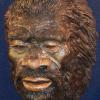I grew up in Washoe County, Nevada. My father was a geologist so we were frequently out in the middle of nowhere. There are some weird folks out in the remote small valleys. Religious cults (imagine being approached by a robed monk on a deserted road who was following orders to leave the compound in the middle of nowhere to go out and panhandle in the middle of nowhere), Nazi groups who literally convoy around with halftracks and staff cars in SS uniforms (heart in throat as they pass you).
In the Southeast, while Civil War relic hunting I ran into both pot growers and altars in the middle of nowhere, and on one occasion, an open and empty grave.
There are plenty of human threats.
That said, I consider this. In the wild the biggest influence on male physiology is physical competition between males for the privilege of mating, and potentially for other resources. The biggest rack of antlers makes a difference, and the biggest silverback has the ability to exert its will.
So let's assume that two adult male bigfoot are in competition and it devolves into a wrestling match, or in extreme cases a life and death struggle for control. Bigfoot are obviously built to exert offensive physical strength. Their arms, legs, and torsos are obviously well developed and commensurate with their stature. But look also at the neck musculature. It is greatly enhanced. Why? I believe this to be a defensive strength adaptation to decrease the vulnerability of the head and neck in dominance struggles. This indicates that in a fight, male bigfoot may habitually target the neck as a point of vulnerability. We only see musculature approaching this in sports where damage to the head and neck occur regularly - football, wrestling, boxing, etc. Weightlifting also, but this is not due to direct conflict/competition.
So I don't find it beyond the realm of possibility that a bigfoot attacking a human might attack the human in the same manner that it might attack a competing male bigfoot and attempt to settle an issue by simply breaking the neck, and possibly removing the head.



